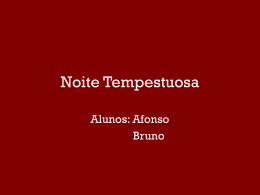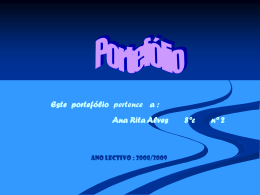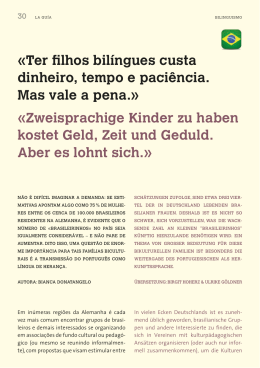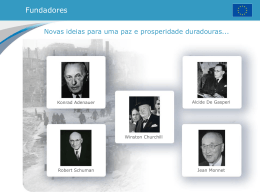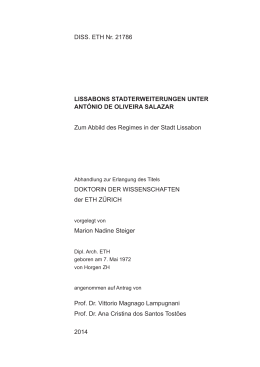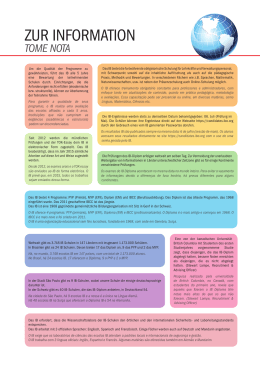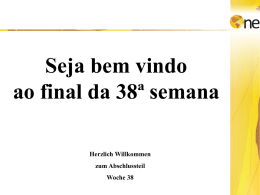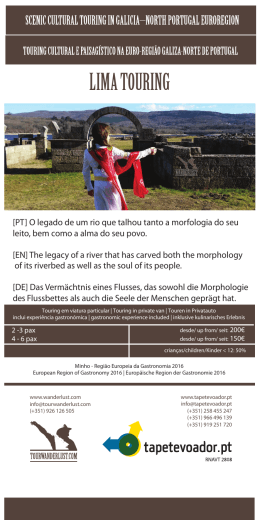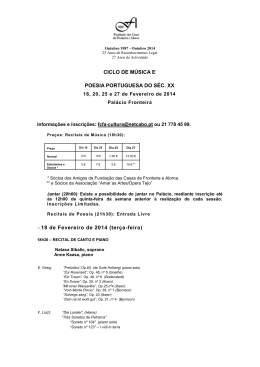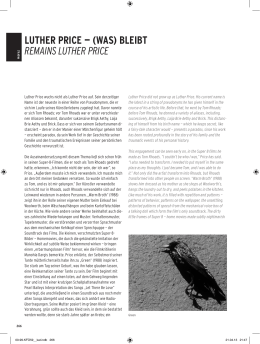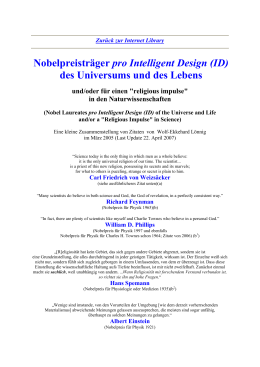Sebastian Benda piano Memoires Sebastian Benda · piano Memoires Franz Liszt (1811–1886) 14 Soneto 104 del Petrarca ................................................ [06:58] CD 1 Ludwig van Beethoven (1770–1827) Total Time CD 1: 83:48 01 32 Variations on an Original Theme in C minor . . . . . . . . . . . . . . . [10:36] Franz Schubert (1797–1828) Sonata in B flat major, Op. posth. CD 2 Heitor Villa-Lobos (1887–1959) 01 Alma brasileira ........................................................... [05:03] 02 03 04 05 Molto moderato .. . . . . . . . . . . . . . . . . . . . . . . . . . . . . . . . . . . . . . . . . . . . . . . . . . . . [13:59] Andante sostenuto .. . . . . . . . . . . . . . . . . . . . . . . . . . . . . . . . . . . . . . . . . . . . . . . . [09:36] Scherzo, Allegro vivace con delicatezza .. . . . . . . . . . . . . . . . . . . . . . . [04:01] Allegro ma non troppo .. . . . . . . . . . . . . . . . . . . . . . . . . . . . . . . . . . . . . . . . . . . . [07:41] 02 03 04 05 Festa no sertão ........................................................... [05:03] Lenda do caboclo ........................................................ [03:59] Impressões seresteiras . ............................................... [06:49] Dança do indio branco ................................................. [03:42] Robert Schumann (1810–1856) Fantasiestücke, Op. 12 Frank Martin (1890–1974) 8 Préludes for Piano 2 06 Des Abends ............................................................... [03:57] 07 Aufschwung .............................................................. [03:45] 08 Warum? . ................................................................... [02:53] 09 Grillen . ..................................................................... [03:41] 10 In der Nacht ............................................................... [04:05] 11 Fabel . ....................................................................... [02:53] 12Traumes-Wirren .......................................................... [02:31] 13 Ende vom Lied ........................................................... [05:03] 06 Grave – Andante . ....................................................... [03:35] 07 Allegretto tranquillo . .................................................. [01:37] 08 Tranquillo ma con moto ............................................... [02:46] 09 Allegro ...................................................................... [01:13] 10 Vivace . ..................................................................... [01:50] 11 Andantino grazioso ..................................................... [01:48] 12Lento – Andante – Lento …. ......................................... [06:16] 13 Vivace . ..................................................................... [03:38] 3 Modest Mussorgsky (1839–1881) Pictures at an Exhibition 14 15 16 17 18 19 20 21 22 23 24 25 26 27 28 29 Promenade . ............................................................... [01:20] Gnomus .................................................................... [02:33] Promenade . ............................................................... [01:01] The Old Castle . .......................................................... [04:54] Promenade . ............................................................... [00:28] Tuileries .................................................................... [01:00] Bydło ........................................................................ [03:17] Promenade . ............................................................... [00:49] Ballet of the Chicks in Their Shells ................................. [01:15] Samuel Goldenberg and Schmuyle ................................. [02:41] Promenade . ............................................................... [01:15] The Marketplace at Limoges ......................................... [01:19] Catacombae (Sepulchrum romanum) .............................. [02:15] Cum mortuis in lingua mortua ....................................... [01:51] The Hut on Fowl’s Legs (Baba Yaga) . ............................. [03:11] The Great Gate at Kiev . ............................................... [04:31] Artist Consort was originally (only) the name for an idea. The musicians François Benda and Felix Renggli had been dreaming of an alternative approach to how classical music recordings were produced in the CD industry. They felt that it should be up to the very best performing artists, not the market, to determine which classical CDs are produced. Instead of classical “fast food,” artistic ethos and independence, creative imagination, and virtuosity. Genuin is now providing the platform for this vision. The German label and the collective of artists, sound engineers and musicians are collaborating in the production of CD recordings which enjoy the full support and commitment of everyone involved, and in every detail bear the stamp of the Artist Consort. From the selection of repertoire to the booklet notes, from tonal nuances to the choice of artists —the musicians make their own decisions about all the important questions regarding their recordings with the support of the Genuin team. In tribute to the flowering of ensemble music in the 17th century, the name of the series of CDs featuring works from the Baroque period to New Music stands for equality, the highest standards, and vibrant artistry—Artist Consort. Total Time CD 2: 81:14 4 5 Artist Consort war zunächst (nur) der Name für eine Idee. Die Musiker François Benda und Felix Renggli träumten von einem Gegenentwurf zur gängigen Praxis des CD-Business. Nicht der Markt sollte Gesetze für Tonträger-Produktionen diktieren, sondern der künstlerische Impetus hochrangiger Musiker die Richtschnur liefern. Kein Fast-Food, sondern künstlerisches Ethos und Eigenständigkeit, schöpferische Fantasie und Virtuosität. Genuin liefert nun die Plattform für diese Vision. In enger Zusammenarbeit von Label und Künstler-Kollektiv, von Tonmeister und Musiker entstehen CDs, hinter denen alle Beteiligten mit voller Überzeugung stehen und die bis ins kleinste Detail die Handschrift des Artist Consort tragen. Von der Werkauswahl bis zum Booklettext, von der Klanggestaltung bis zur Besetzungsliste: Unterstützt vom Genuin-Team entscheiden die Musiker alle wichtigen Fragen rund um ihre Aufnahmen selbst. Und als Hommage an die hohe Zeit der Ensemblemusik im 17. Jahrhundert tragen die CDs vom Barock bis zur Avantgarde einen Titel, der für Gleichberechtigung genauso wie für höchste Ansprüche und lebendige Kunst steht: Artist Consort. 6 ARTIST CONSORT foi inicialmente apenas o nome atribuido a uma idéia. Os músicos François Benda e Felix Renggli sonharam com um contra-projeto para substituir as práticas habituais em matéria de produção de cds. Em relação à realização de cds e outros suportes sonoros, não competiria então ao mercado de ditar suas leis mas sim ao impulso artístico dado por músicos de alto nivel, que indicariam as normas a serem alcançadas. Em vez de « fast- food » musical, procurarse-ia respeitar uma ideologia artística reunindo num mesmo equilibrio a autonomia, a imaginação e a virtuosidade. Genuin oferece a plataforma a esta visão. A produção dos cds leva, nos mínimos detalhes, o sêlo da coleção « Artist Consort », coletivo artístico de músicos e engenheiros de som, que trabalhando em estreita colaboração contribuem com sua adesão artística à realização dos projetos. Desde a escolha das obras a serem gravadas até o texto dos libretos dos cds, bem como a concepção sonora, a propria distribuição artística e os assuntos concernentes à gravação, são decididos pelos artistas, apoiados pela equipe Genuin. O nome Artist Consort foi dado em homenagem à música de conjunto, que teve seu apogeu no século XXVII. Os cds da coleção, que vão da época barroca até a música de vanguarda, levam o mesmo título, simbolo de igualdade, exigências elevadas, bem como de uma arte viva : Artist Consort. 7 Memoires – Sebastian Benda, Pianist (8 April 1926 – 20 February 2003) Sebastian Benda, when first beginning his studies with Frank Martin 8 From the Baroque period until the early 20th century great musicians were not only instrumental virtuosos but also creators of their own works. Many of them, such as for example Johann Sebastian Bach, Wolfgang Amadeus Mozart, or Ferruccio Busoni too came from important musical families or had their roots in an environment in which music was already a dominant part of their daily lives during childhood. The pianist Sebastian Benda too was born into a long musical tradition in 1926: His father, the Swiss native Jean Benda, was a well-known violin teacher who taught at the Hoch’sche Konservatorium in Frankfurt am Main until the seizure of power by the National Socialists. In 1933 he returned to Switzerland with his two children—Lola and Sebastian—and his wife Dora Hamann Benda, a violist and poet, who was solo violist with the Beromünster Radio Orchestra under conductor Hermann Scherchen. When his parents recognized the precocious musical talent of their son they started by teaching him music themselves before having various teachers of piano, harmony and counterpoint instruct him. When he was only nine, Sebastian’s compositions attracted the attention of renowned composers such as Arthur Honegger, Frank Martin, Alfredo Casella and Joaquin Nin, who predicted a brilliant future for the talented youngster. Frank Martin declared his willingness to support Sebastian’s development as a composer and to become his teacher. In view of the career difficulties of composers at that time Martin wrote to his pupil’s parents: 9 “It is important that Sebastian dedicates himself to the serious study of an instrument, for the composer’s métier does not offer anyone a genuine way of making a living unless he or she concentrates on composing tangos and march music.” Years later in an article dedicated to Frank Martin, Sebastian Benda recalled: After receiving this letter I doubled my effort on the piano, but continued to compose with all my heart. Although in the judgment of renowned musicians I was precocious and studied harmony and counterpoint, composing was a very personal act of letting go for me, a spiritual state in which music served as the medium for direct expression. He also wrote: My personal recollections of Frank Martin come from my childhood, when I became his pupil in composition at the age of eleven. In Geneva he analyzed my compositions with great wisdom and gave me valuable advice. From that time on Martin was always there in the various phases of my life, whether as a composer, a teacher, an artist, a person or a friend. Already at the age of eleven Sebastian often stood on the podium as the partner of his older sister, the violinist Lola Benda, and in a short time he also acquired an impressive piano repertoire, which made it possible for him to give piano recitals in Switzerland at the early age of thirteen and to commence studies at the Geneva Conservatorium. 10 After completing his studies with the Prix de virtuosité he was invited by the pianist Edwin Fischer, who recognized the exceptional potential of the young pianist, to become his master student. Sebastian Benda was one of the few pupils whom Fischer taught for a longer period. He studied with Fischer for seven years and in this way received the essence of a transcendental art, a piano tradition which, starting with Edwin Fischer, via Martin Krause, Franz Liszt and Carl Czerny formed a direct genealogical line to Ludwig van Beethoven. Together with Edwin Fischer, at an early age Benda performed as a soloist in several concert series in Switzerland. This marked the beginning of a career as a solo pianist which ultimately took him to 40 countries in Europe, Asia and North and South America. After Fischer’s death Sebastian Benda wrote this about his teacher: I was given the privilege of becoming very closely acquainted with Edwin Fischer. Not only was I his pupil, I was also given the honor of performing concertos for piano and orchestra by Mozart and Bach under his direction. Fischer was one of the last personalities who in our age of objectivity preserved the mystical art of sensitivity for sound. He was much more than a great pianist: he was a great musician with the rare gift of being able to communicate the joy and mystery of a composition. He possessed great charisma and sought after the true value of an art which was constantly renewing itself; he was a creator of the new in the truest sense of the word. Despite his profound musical knowledge he was a highly 11 instinctive musician. He taught us this: ‘You should not seek anything in the music; it reveals itself to you on its own. Make this invisible link so that the composer’s flow of ideas comes to you: listen, listen, listen…’ The search for new values in post-war Europe manifested itself in music too in a radical break with composing traditions. This “mood of regeneration” in the first years after World War II also affected the young Benda, who now dedicated himself more strongly to the interpretation of contemporary music: for instance, among other things in 1949 he participated as pianist and chamber musician at the “Tage für Neue Musik” in Darmstadt. The in his view unfathomable divergence of paths of development found in New Music of the 1950s led to his decision to devote himself from then on exclusively to performing in concert and recital. In 1952 he went on a tour of South America. In Brazil he discovered a new and fascinating world which impressed him to such an extent that he decided to settle there. Years later he wrote about this: In Brazil the countryside, the climate, the people and the way of life in general were completely different from what I was used to, and many principles that I subscribed to had to be extended through a new way of looking at things and through tolerance so that I could be positively affected by these differences. During a recital with his sister Lola 12 Benda rapidly expanded his repertoire to include the works of Heitor Villa-Lobos and other South American composers, which he subsequently performed all over the world. 13 With Luzia do Eirado Dias, a music teacher, he founded a family which was to produce five children – Angela, Christian, François, Nancy and Denise. Today they are all professional musicians, with whom their father often performed concerts in his later years. Sebastian Benda lived in Brazil for 29 years in all (1952–1981); almost three decades which were, however, interrupted by regular concert tours to Europe and Asia: As a soloist he performed with orchestras such as the Tonhalle Orchestra in Zurich, the Orchestre de la Suisse Romande, NDR Hamburg, the Frankfurt Radio Symphony Orchestra, the Kol Israel Orchestra Jerusalem, The Hague Philharmonic, the George Enescu Philharmonic Orchestra Bucharest, the Osaka Philharmonic Orchestra and the Sofia Philharmonic Orchestra. Leading conductors such as Hermann Scherchen, Hans von Hoesslin, Hans Schmidt-Isserstedt, Erich Schmidt, Ernest Bour, Takashi Asahina or Eleazar de Carvalho valued Benda as a congenial partner. In 1958 Sebastian Benda was honored with the Bach Medal of the Harriet Cohen International Music Award Council after performing three piano recitals with different programs in London’s Wigmore Hall within a single week. The intensive cooperation with Frank Martin, which lasted until the composer’s death in 1974, reached its high point in the complete recording of Martin’s works for piano. In one of the many lectures Sebastian Benda gave around the world, he described his relationship with Martin in the following way: “To me Frank Martin was not only an incomparable composer whose works gripped audiences on the different continents with their emotionality; to me he was the master, teacher, adviser, friend and in the final analysis conductor of his own works with whom I had the honor to work.” 14 During his time in Brazil Benda’s artistic engagement was equally intensive and varied: He initiated concert series, founded chamber music ensembles, worked out plans for developing Brazilian cultural life and cooperated with several faculties of music in the country and was ultimately honored by the Brazilian government with the Villa-Lobos Medal. After being appointed a faculty member of the Hochschule für Musik und darstellende Kunst in Graz, Austria, Sebastian Benda returned to Europe with his family in 1981 to work until 1994 as professor and rector at what is now the University of Music and Performing Arts Graz (KUG). In this phase of his life he emphasized teaching piano. In numerous performance classes at various universities in for instance Paris, Cologne, Basel or Tokyo, in his master classes for piano and chamber music and through his lecture-recitals, which combined his broad knowledge of the history of music with highly sensitive interpretations, he made a lasting impression on whole generations of young musicians. Right up to the last moments of his life in February 2003, Sebastian Benda devoted himself totally to music by composing cadenzas, completed transcriptions, arranged works from the 18th century and recorded chamber music with his children. Sebastian Benda was a great humanist whose charismatic personality and strong presence were a powerful attraction to all people, as was especially obvious with concert audiences. His playing, like his character, was marked by great poetry and simplicity, as well as great energy and vitality, entirely in a Schumannesque sense. Like his teacher, Edwin Fischer, he was also a musician of great depth, in whose interpretations there was no place for the superficial or superfluous. 15 Sebastian Benda – Thoughts on Music Beethoven’s art reflects the way he was in life: lonely, unique and at the same time sublime. Before him music was always composed for a specific purpose, whether it was to praise God or to entertain the public and the nobility. With Beethoven a radical change occurs; his entire soul reveals itself to us in his gigantic and multifaceted body of work. Beethoven’s music is a magnificent and gripping manifestation of his inner world of feelings, with all his suffering and yearning. The spirit of innovation and revolution wells up in it. The more I immerse myself in artistic work the more I become aware that although we can acquire musical knowledge, in the final analysis it is the way we imagine the sound which influences our interpretations most of all. Schubert’s works are impressive for their compositional sensitivity and sensibility, their extremely fine dynamic gradations and through changes of key which exert a light-dark effect on the listener and which create a subtle overall musical atmosphere. Schumann’s style is characterized by a large number of motifs which bear witAt a master class with Edwin Fischer in Lucerne 16 ness to the composer’s unusual powers of imagination. To me Schumann is the prototypical Romantic composer who expresses musical ideas with the support of literary thoughts: This involves highly inspired music. 17 The eight Fantasiestücke, Op. 12, although separate pieces in their own right, constitute a unified whole. They are musical creations in which “Eusebius,” the dreamer, and “Florestan,” the passionate one, express themselves in various states of transformation; the pieces contrast with each other and are full of poetry, with titles that do not indicate a musical program but instead suggest the unreal, which wakens our emotional understanding of what we hear. The series ends with final chords in the bass register in an atmosphere of absolute peace. After experiencing the full breadth of expression from the intimate to joyful enthusiasm, this gives listeners a sense of deep contemplation. The last remnants of the motifs become weaker and weaker until finally only the key in the deep chords can be heard, bringing this collection to a close. Liszt constantly emulated the thoughts of the great poets and philosophers and set three sonnets of Petrarch, one of the great humanists of the Renaissance, to music. Soneto 104 del Petrarca bears witness to Petrarch’s great inventiveness; the intensity of his lines causes readers to tremble. Liszt did not set the poem to music; instead he describes the spiritual state of ecstasy after reading it. Liszt was of decisive importance in the history of music: We must remember that Liszt was the real father of the modern piano and at the same time a great performer of the late Beethoven sonatas. Liszt was not only a great virtuoso, he was also a pioneer of piano technique and a composer whose significance was made clear by the creation of symphonic poems where his highly dramatic style of writing is evident: He introduced chromatic writing to be found later in Wagner’s works. As a “sound magician” of unexcelled talent he transformed the piano into a richly expressive instrument comparable to an orchestra. 18 Villa-Lobos undoubtedly represents one of the high points of Brazilian and Latin American music in general. The expressive force, rhythm and clearly folkloristic elements of his highly intuitive music speak directly to listeners. Villa-Lobos’s personality is energetic and highly authentic; his music is the music of Brazil, the music of the jungle and the sertão, the dry outback in the northeast, and the music of the sea. It describes the unique characteristics of the people, the way of life and the natural environment of Brazil and is uncommonly vital and impressive. He transforms the folklore, which has a regional character at its center, into a universal language whose message reaches audiences on all continents with ease. Just as Alfred Cortot gave Frédéric Chopin’s individual preludes titles, the same could be done with Martin’s 8 Préludes, so rich is their wealth of emotion and color. For every prelude the composer makes use of a different expressive palette, extending from dramatic means to highly subtle and unreal atmospheres. Martin’s way of writing for the piano is truly perfect; it demonstrates his sensitivity for the resonances in the different registers of the instrument. Although he carried on musical research throughout his entire life, he did not allow himself to be aligned with any artistic school and always remained true to himself and his own aesthetic principles. Like a large tree during a storm he remained firmly rooted; his eight preludes are indisputable proof of that. When Mussorgsky visited an art exhibition of Viktor Hartmann he was so overcome by his deceased friend’s pictures that he was inspired to compose a series of small pieces which together make up the cycle Pictures at an Exhibition. 19 Mussorgsky employed an abrupt, unconventional, and completely new way of composing for piano. This was met with indifference by the pianists of his time. Noone was very interested in the piece, with the result that the work led a Cinderellalike existence for a quarter of a century. Nowadays this monumental work is often performed worldwide, both in the original version for piano and also in an orchestrated version by Maurice Ravel. For an artistic work, just as for an artist, a special set of circumstances is often called for so that it can be in the spotlight and optimally evaluated by its beholders or listeners. Artists and works of music are exposed to a constantly changing series of critical rankings, an ebb and flow of judgment. In São Paulo on first concert tour of South America, 1952 20 21 Memoires – Sebastian Benda, Pianist (8. April 1926 – 20. Februar 2003) Von der Barockzeit bis in das frühe 20. Jahrhundert hinein traten große Musiker sowohl als Instrumentalvirtuosen als auch als Schöpfer eigener Werke in Erscheinung. Viele von ihnen, wie etwa Johann Sebastian Bach, Wolfgang Amadeus Mozart oder auch Ferruccio Busoni, entstammten bedeutenden Musikerfamilien oder waren in einem Umfeld verwurzelt, in dem die Musik schon in ihrer Kindheit zu einem bestimmenden Bestandteil ihres täglichen Lebens wurde. Auch der Pianist Sebastian Benda wurde 1926 in eine lange musikalische Tradition hineingeboren: Sein Vater, der Schweizer Jean Benda, war ein bekannter Violinpädagoge, der bis zur Machtergreifung der Nationalsozialisten am „Hoch’schen Konservatorium“ in Frankfurt am Main unterrichtete. Im Jahr 1933 kehrte er mit seinen beiden Kindern – Lola und Sebastian – und seiner Frau Dora Hamann Benda, einer Bratschistin und Dichterin, die als Solobratschistin im Radioorchester Beromünster des Dirigenten Hermann Scherchen wirkte, in die Schweiz zurück. Als die Eltern das frühreife Talent ihres Sohnes für die Musik erkannten, unterwiesen sie ihn zunächst selbst in Musikkunde, ehe sie ihn verschiedenen Lehrern für Klavier, Harmonie und Kontrapunkt anvertrauten. Bereits im Alter von neun Jahren zogen Sebastians Kompositionen die Aufmerksamkeit namhafter Komponisten wie Arthur Honegger, Frank Martin, Alfredo Casella und Joaquin Nin auf sich, die dem jungen Talent eine glänzende Zukunft vorhersagten. Frank Martin erklärte sich bereit, Sebastians Entwicklung auf dem Gebiet der 22 Komposition zu begleiten und sein Lehrer zu werden. In Anbetracht der beruflichen Schwierigkeiten von Komponisten jener Zeit schrieb Martin allerdings an die Eltern seines Schülers: „Es ist wichtig, dass Sebastian sich ernsthaft dem Studium eines Instrumentes widmet, denn das Metier des Komponisten bietet niemandem eine echte Lebensgrundlage, außer er verschreibt sich dem Komponieren von Tangos und Marschmusik.“ Jahre später erinnert sich Sebastian Benda in einem Frank Martin gewidmeten Artikel: „Nach Erhalt dieses Briefes, verdoppelte ich mein Pensum am Klavier, komponierte aber weiterhin mit Leidenschaft. Obwohl ich nach dem Urteil hoch angesehener Musiker als frühreif galt und ich mich in Harmonielehre und Kontrapunkt übte, stellte das Komponieren für mich einen sehr persönlichen Akt des Loslösens dar, einen seelischen Zustand, in welchem die Musik mir als Medium des unmittelbaren Ausdrucks diente.“ Und weiter: „Meine persönlichen Erinnerungen an Frank Martin stammen aus meiner Kindheit, als ich im Alter von elf Jahren sein Kompositionsschüler wurde. In Genf analysierte er mit großer Weisheit meine Kompositionen und gab mir wertvolle Ratschläge. Seitdem war Martin in den verschiedenen Phasen meines Lebens stets präsent, sei es als Komponist, Pädagoge, Künstler, Mensch oder Freund.“ Schon im Alter von elf Jahren stand Sebastian häufig als Partner seiner älteren Schwester, der Geigerin Lola Benda, auf dem Konzertpodium, zudem erarbeitete er sich in kurzer Zeit ein beachtliches Klavierrepertoire, das ihm ermöglichte, bereits 23 mit dreizehn Jahren Klavierabende in der Schweiz zu geben und ein Studium am Genfer Konservatorium zu beginnen. Nach dem Abschluss dieses Studiums mit dem Prix de virtuosité wurde er vom Pianisten Edwin Fischer, der das außergewöhnliche Potenzial des jungen Pianisten erkannte, eingeladen, sein Meisterschüler zu werden. Sebastian Benda war einer der wenigen Schüler, die Fischer über einen langen Zeitraum betreute. Sieben Jahre lang lernte er bei ihm und empfing so die Essenz einer transzendenten Kunst, einer pianistischen Tradition, die, ausgehend von Edwin Fischer über Martin Krause, Franz Liszt und Carl Czerny eine direkte genealogische Linie zu Ludwig van Beethoven bildet. Gemeinsam mit Edwin Fischer trat Benda noch in sehr jungen Jahren als Solist in mehreren Konzertzyklen in der Schweiz auf. Das war der Beginn einer pianistischen Karriere, die ihn schließlich in 40 Länder in Europa, Asien und in Nord-und Südamerika führen sollte. Nach dem Tod Fischers schrieb er: „Mir war das Privileg, Edwin Fischer ganz von der Nähe zu kennen, vergönnt. Ich war nicht nur sein Schüler, mir wurde auch die Ehre zuteil, Konzerte für Klavier und Orchester von Mozart und Bach unter seiner Leitung aufzuführen. Fischer war eine der letzten Persönlichkeiten, die in unserer Epoche der Objektivität die mystische Kunst der klanglichen Empfindungen pflegte. Er war viel mehr als ein großer Pianist: ein großer Musiker mit der seltenen Gabe, die Freude und das Geheimnis eines musikalischen Werkes zu übermitteln. Er besaß eine große Ausstrahlungskraft und suchte nach den wahren Werten einer sich immer erneuernden Kunst, er war ein Neu-Schöpfer im wahrsten Sinne des Wortes. Trotz seiner profunden musikalischen Kenntnisse war er ein höchst instinktiver 24 At his first home in Salvador, Bahia, Brazil 25 Musiker. Dies lehrte er uns: ‚In der Musik soll man nichts wollen, sie offenbart sich einem von selber. Stellt jene unsichtbare Verbindung her, damit der Gedankenfluss des Komponisten Euch erreiche: höret, höret, höret ...‘ “ Die Suche nach neuen Werten im Europa der Nachkriegszeit manifestierte sich auch in der Musik in einem radikalen Bruch mit kompositorischen Traditionen. Diese „Aufbruchstimmung“ der ersten Nachkriegsjahre beeinflusste auch den jungen Benda, der sich nunmehr verstärkt der Interpretation zeitgenössischer Musik widmete: so nahm er u. a. 1949 als Pianist und Kammermusiker an den Tagen für Neue Musik in Darmstadt teil. Die in seinen Augen unüberschaubare Divergenz der aktuellen Entwicklungslinien der Neuen Musik der 50er Jahre führte zu seinem Entschluss, sich ab dieser Zeit ausschließlich der musikalischen Interpretation zu verschreiben. Im Jahr 1952 unternahm Benda eine Tournee nach Südamerika. In Brasilien entdeckte er eine neue und faszinierende Welt, die ihn in einem solchem Maße beeindruckte, dass er beschloss, sich dort niederzulassen. Er schrieb Jahre später darüber: „In Brasilien waren die Landschaft, das Klima, die Menschen und das Leben im Allgemeinen ganz anders, als ich es gewohnt war, und viele Prinzipien, die mir zu eigen waren, mussten durch eine neue Sichtweise und durch Toleranz erweitert werden, damit ich diese Verschiedenheiten positiv aufnehmen konnte.“ Rasch erweiterte Benda sein Repertoire um die Werke von Heitor Villa-Lobos und anderen südamerikanischen Komponisten, die er in der Folge weltweit zur Aufführung brachte. Mit Luzia do Eirado Dias, einer Musikpädagogin, gründete er eine Familie, aus der fünf 26 Kinder – Angela, Christian, François, Nancy und Denise – hervorgehen sollten. Sie alle sind heute professionelle Musiker, mit denen der Vater in seinen späten Jahren häufig konzertierte. Ganze 29 Jahre (1952–1981) lebte Sebastian Benda in Brasilien; fast drei Jahrzehnte, die allerdings von regelmäßigen Konzerttourneen nach Europa und Asien unterbrochen wurden: Als Solist trat er mit Orchestern wie dem Tonhalle Orchester Zürich, dem Orchestre de la Suisse Romande, NDR Hamburg, dem Hessischen Rundfunk Sinfonieorchester, Kol Israel Orchestra Jerusalem, dem Residentie Orkest Den Haag, dem George Enescu Philharmonic Orchestra Bukarest, dem Osaka Philharmonic Orchestra und dem Sofia Philharmonic Orchestra auf. Bedeutende Dirigenten, wie etwa Hermann Scherchen, Hans von Hoesslin, Hans Schmidt-Isserstedt, Erich Schmidt, Ernest Bour, Takashi Asahina oder Eleazar de Carvalho, schätzten Benda als kongenialen Partner. 1958 wurde Sebastian Benda mit der Bach-Medaille des Harriet Cohen International Music Award Council ausgezeichnet, nachdem er innerhalb einer Woche in der Londoner Wigmore Hall drei Klavierabende mit verschiedenen Programmen gegeben hatte. Die intensive, bis zum Tode des Komponisten im Jahre 1974 währende Zusammenarbeit mit Frank Martin gipfelte in der Gesamteinspielung des Martin’schen Klavierwerkes. In einem der vielen Vorträge, die Sebastian Benda weltweit gab, beschrieb er seine Beziehung zu Martin wie folgt: „Frank Martin war für mich nicht nur der unvergleichliche Komponist, dessen Werke mit ihrer Emotionalität das Publikum in den verschiedenen Kontinenten zu ergreifen vermögen, für mich war er auch der Meister, Lehrer, Berater, Freund und schließlich der Dirigent seiner eigenen Werke, mit dem ich die Ehre hatte, zusammenzuarbeiten.“ 27 At the “Garden of Alah” in Bahia, Brazil 28 Während seines Aufenthaltes in Brasilien war Bendas künstlerisches Engagement ebenso intensiv wie vielfältig: Er rief Konzertreihen ins Leben, gründete Kammermusik-Ensembles, arbeitete Pläne zur Entwicklung des brasilianischen Kulturlebens aus und kooperierte mit mehreren Musikfakultäten im Land, sodass er schließlich durch die brasilianische Regierung mit der Villa-Lobos-Medaille geehrt wurde. Nach seiner Berufung an die Hochschule für Musik und darstellende Kunst in Graz, Österreich, kehrte Sebastian Benda mit seiner Familie 1981 nach Europa zurück, um bis 1994 als Professor und Rektor an der heutigen Grazer Kunstuniversität zu wirken. In dieser Phase seines Lebens rückte die Klavierpädagogik ins Zentrum seiner Aktivitäten. In zahlreichen Interpretationskursen an verschiedenen Musik-universitäten, wie etwa in Paris, Köln, Basel oder auch Tokio, in seinen Meisterkursen für Klavier und Kammermusik und durch seine, umfassendes musikhistorisches Wissen mit hochsensiblen musikalischen Interpretationen verbindenden, Lecture-Recitals prägte er ganze Generationen von jungen Musikern maßgeblich. Bis zu den letzten Augenblicken seines Lebens, im Februar 2003, widmete sich Sebastian Benda gänzlich der Musik, indem er Kadenzen komponierte, Transkriptionen anfertigte, Werke des 18. Jahrhunderts bearbeitete und Kammermusikwerke mit seinen Kindern einspielte. Sebastian Benda war ein großer Humanist, dessen charismatische Persönlichkeit und starke Präsenz eine starke Anziehungskraft auf alle Menschen, insbesondere freilich auf das Konzertpublikum ausübten. Sein Spiel wie sein Charakter waren von großer Poesie und Einfachheit, wie auch von großer Energie und Vitalität gekennzeichnet, ganz im Schumannschen Sinne. Wie sein Lehrer Edwin Fischer war auch er ein Musiker von großer Tiefe, in dessen Interpretationen das Oberflächliche und das Überflüssige keinen Platz hatten. 29 Sebastian Benda – Gedanken zur Musik Beethoven erscheint in seiner Kunst, wie er in seinem Leben war: einsam, einzigartig und zugleich erhaben. Vor ihm wurde Musik stets zu einem bestimmten Zweck komponiert, sei es zum Lobpreis Gottes oder zur Unterhaltung des Publikums und der Adeligen. Mit Beethoven tritt eine radikale Änderung ein, seine ganze Seele offenbart sich uns in seinem gigantischen und vielschichtigen Werk. Beethovens Musik ist eine großartige und ergreifende Übertragung seiner Gefühlswelt mit all seinen Leiden und Sehnsüchten. Aus ihr spricht der Geist der Innovation und Revolution. Je mehr ich mich in die künstlerische Arbeit vertiefe, desto mehr wird mir bewusst, dass wir uns zwar musikalisches Wissen aneignen können, dass es aber letzten Endes unsere Klangvorstellung ist, die unsere Interpretationen am allermeisten beeinflusst. Schuberts Werke bestechen durch kompositorische Sensitivität und Sensibilität, durch feinste dynamische Abstufungen und durch Tonartenwechsel, die eine Hell-Dunkel-Wirkung auf den Hörer ausüben und allesamt eine subtile musikalische Atmosphäre schaffen. Der Schumannsche Stil ist durch eine Fülle an Motiven gekennzeichnet, die von der ungewöhnlichen Vorstellungskraft des Komponisten zeugen. Schumann ist für mich der Prototyp des romantischen Komponisten, der musikalische Ideen 30 mit der Unterstützung literarischer Gedanken ausdrückt: Es handelt sich hier um eine höchst inspirierte Musik. Die acht Fantasiestücke op. 12, obwohl voneinander unabhängig, bilden ein Ganzes. Es handelt sich um musikalische Schöpfungen, in denen „Eusebius“, der Träumer, und „Florestan“, der Leidenschaftliche, sich in verschiedenen Verwandlungsformen ausdrücken; es handelt sich um einander kontrastierende Stücke voller Poesie, deren Titel kein musikalisches Programm bedeuten, sondern das Irreale suggerieren, wodurch unser emotionales Hörverständnis geweckt wird. Die Serie endet mit letzten Akkorden im Bass-Register in einer Atmosphäre absoluter Ruhe. Dadurch wird dem Hörer ein Gefühl von tiefer Kontemplation vermittelt, nachdem zuvor das gesamte Ausdrucksspektrum vom Intimen bis zum Überschwänglichen vorgeführt wurde. Die letzten Überreste der Motive werden immer schwächer, bis schließlich nur die Tonart in den tiefen Akkorden zu vernehmen ist, womit dieses Album endet. Liszt eiferte stets den Gedanken der großen Dichter und Philosophen nach und setzte so drei Sonette von Petrarca, einem der großen Humanisten der Renaissance, in Musik. Das Soneto 104 del Petrarca zeugt von Petrarcas großem Einfallsreichtum, die Intensität seiner Verse lassen den Leser erzittern. Liszt vertont das Gedicht nicht, sondern beschreibt den seelischen Zustand der Extase nach dessen Lektüre. Für die Musikgeschichte war Liszt von entscheidender Bedeutung: Wir erinnern uns, dass Liszt der wirkliche Vater des modernen Klaviers und zugleich ein großer Interpret der letzten Beethoven-Sonaten war. Liszt war nicht nur ein großer Virtuose, sondern auch ein Pionier der Klaviertechnik und ein Komponist, dessen Bedeutung durch die Schaffung der symphonischen Dichtung offenbar wurde, in 31 der wir seine höchst dramatische Handschrift erkennen: Er setzte jene Chromatik ein, die wir später in den Werken Wagners wiederfinden. Als „Klangmagier“ von unübertroffenem Talent verwandelte er das Klavier in ein ausdrucksvolles Instrument, das mit einem Orchester verglichen werden konnte. Villa-Lobos stellt zweifellos einen der Höhepunkte der Musik Brasiliens und Lateinamerikas im Allgemeinen dar. Seine höchst intuitive Musik spricht den Hörer durch ihre Ausdruckskraft, ihren Rhythmus, und ihre offenkundigen folkloristischen Elemente direkt an. Villa-Lobos’ Persönlichkeit ist energisch und höchst authentisch, seine Musik ist die Musik Brasiliens, die des Dschungels und des „Sertão“, des trockenen Hinterlandes im Nordosten, und die Musik des Meeres. Sie beschreibt die Eigenheiten des Volkes, das Leben und die Natur Brasiliens, und ist ungemein vital und beeindruckend. Die Folklore, die im Kern einen regionalen Charakter hat, verwandelt er in eine universelle Sprache, deren Botschaft das Publikum auf allen Kontinenten mit Leichtigkeit erreicht. So, wie Alfred Cortot den einzelnen Préludes von Frédéric Chopin Titel verlieh, könnte man auch mit Frank Martins 8 Préludes für Klavier verfahren, dermaßen groß ist deren Reichtum an Emotionen und Farben. Für jedes Präludium bedient sich der Komponist einer anderen Ausdruckspalette, die vom dramatischen Ausdruck bis zu höchst subtilen und irrealen Atmosphären reicht. Wahrhaftig vollkommen ist Martins Schreibweise für das Klavier, die auf seine Sensibilität für die Resonanzen in den verschiedenen Lagen des Instrumentes hinweist. Obwohl er sein Leben lang musikalisch forschte, ließ er sich von keiner 32 In the 1960s 33 künstlerischen Strömung vereinnahmen und blieb sich und seinen ästhetischen Prinzipien stets treu. Wie ein großer Baum während eines Sturms blieb er fest verwurzelt, seine acht Préludes sind ein unwiderlegbarer Beweis dafür. Als Mussorgsky eine Ausstellung seines verstorbenen Freundes Viktor Hartmann besuchte, war er von dessen Bildern so überwältigt, dass er zur Komposition einer Reihe kleiner Stücke, die zusammen den Zyklus der Bilder einer Ausstellung bilden, angeregt wurde. Mussorgsky bediente sich einer abrupten, unkonventionellen und völlig neuartigen Schreibweise für das Klavier. Damit stieß er bei den Pianisten seiner Zeit auf Unverständnis; man interessierte sich nicht sonderlich für das Stück, sodass das Werk ein Vierteljahrhundert lang ein Schattendasein fristete. Heutzutage wird dieses monumentale Werk sowohl in der Originalfassung für Klavier als auch in der Orchestrierung von Ravel weltweit gerne aufgeführt. Für ein Kunstwerk wie für einen Künstler bedarf es oft einer besonderen Konstellation, um im Rampenlicht stehen zu können und von seinen Rezipienten optimal bewertet zu werden. Sie sind einer sich ständig ändernden hierarchischen Reihung ausgesetzt, einem Auf und Ab der Einschätzungen. 34 Memoires – Sebastian Benda, pianista (08 Abril1926 – 20 Fevereiro 2003) Do barroco até inícios do século XX grandes músicos foram virtuoses do seu instrumento e ao mesmo tempo também músicos criadores. Muitos deles provinham de familia de músicos ou eram enraizados em um meio musical : a música fazia parte do seu cotidiano. De Bach, passando por Mozart, Busoni e muitos outros podemos observar um acesso similar à música e assim foi também com Sebastian Benda. Ele nasceu em 1926 num berço de longa tradição musical, onde a música era onipresente. Seu pai, Jean Benda, suiço, conhecido pedagogo do violino, ensinava no « Hochsche Konservatorium de Frankfurt am Main », até que a Alemanha se tornou nacional-socialista. Em 1933 ele voltou para a Suiça com seus dois filhos, Lola e Sebastian, e sua esposa Dora Hamann Benda, violista e poetisa,que atuou como primeira viola da Radio-Orquestra Beromünster do regente Hermann Scherchen. Notando o talento precoce do filho, os pais acompanharam os seus primeiros passos no aprendizado musical encaminhando-o aos professores de piano e de conhecimentos musicais, como harmonia e contraponto. Já aos 9 anos as suas composições chamaram a atenção de músicos notáveis da época como Arthur Honegger, Frank Martin, Alfredo Casella, Joaquin Nin e outros, que lhe predisseram um brilhante futuro musical. Frank Martin se dispôs a seguir o seu desenvolvimento no campo da composição tornando-se seu professor. Considerando as dificuldades profissionais do compositor na época, Martin escreveu a seus pais: 35 « É importante que Sebastian estude a fundo um instrumento porque a não ser escrevendo tangos ou marchas militares,o métier de compositor não permite a subsistência de ninguém. » Anos mais tarde Sebastian Benda se recordava deste fato num artigo sobre Frank Martin escrevendo : « Depois do recebimento desta carta, dobrei o tempo do meu estudo de piano continuando a compor com paixão. Mesmo que eu fosse precoce, segundo o parecer de músicos muito respeitados e apesar de estudar a harmonia e o contraponto, a composição musical representava para mim uma liberação íntima, um estado d` alma, no qual a música era o canal de expressão o mais imediato. » No mesmo artigo acrescentou : « Minhas lembranças pessoais de Frank Martin datam da minha infância, quando com a idade de 11 anos me tornei seu aluno de composição. Foi em Genebra que ele analizou com grande sabedoria minhas composições dando-me conselhos preciosos. Desde então, Martin foi presente nos diversos períodos da minha vida como compositor, pedagogo, artista, ser humano e amigo. » During a concert tour of Japan 36 Aos 11 anos Sebastian dava concertos em duo com sua irmã Lola, violinista, e desenvolveu rapidamente um grande repertório pianístico que lhe permitiu de dois anos mais tarde se apresentar em recitais para piano solo na Suiça e ingressar no Conservatório de Música de Genebra como estudante de piano. Depois de finalizar os seus estudos nesta instituição com o diploma de solista, « Prix de virtosité », foi convidado pelo pianista Edwin Fischer a ser seu discípulo, 37 o qual reconhecendo o potencial do jovem Sebastian legou o seu profundo conhecimento musical baseado especialmente na tradição dos compositores Bach, Mozart, Beethoven, Schubert, Schumann e Brahms. Sebastian Benda foi um dos poucos discipulos de Fischer a seguir seus ensinamentos longamente – 7 anos – tempo que lhe permitiu de captar a essência de uma arte transcendente e de uma tradição musical proveniente de uma linha genealógica pianística direta de Edwin Fischer, passando por Martin Krause, Franz Liszt, Carl Czerny e chegando a Ludwig van Beethoven. Com Edwin Fischer, Sebastian, muito jovem apresentou-se tocando ao seu lado como solista em diversos ciclos de concertos. Este foi o início de uma carreira pianística que o levou a 40 paises da Europa, Asia e Americas. O pós-guerra na Europa, foi marcado por grandes pertubações. De um lado a reconstrução das cidades destruidas e do outro a busca de novos valores que também na criação musical repercutiu em uma quebra com as tradições. Esta erupção renovadora logo nos primeiros anos pós-guerra também influenciou o jovem Benda que muito ligado à criação musical se tornou também um intérprete de música contemporânea. Apresentando-se como pianista e camerista no novo Festival de Darmstadt em 1949, constatando as diversas direções que a música contemporânea tomava, decidiu de se dedicar desde então exclusivamente à interpretação musical. Em 1952 realizou uma tournée na America do Sul. Chegando ao Brasil descobriu um mundo novo fascinante, que causou um tal impacto sobre o jovem pianista que ele decidiu de radicar-se lá. Após a morte do seu mestre, Sebastian Benda escreveu : « Tive o privilégio de conhecer Edwin Fischer de perto. Não somente estudei sob sua direção como tive a honra de colaborar sob sua regência nos ciclos de concertos para piano e orquestra de Mozart e Bach. Fischer é uma das últimas personalidades que refletem, na nossa época de objetividade, a arte mística das sensações sonoras. Ele foi muito mais que um grande pianista, foi um grande músico, com o raro dom de transmitir a alegria e o mistério de uma obra musical. Foi um ser que tinha uma grande irradiação e que procurava os reais valôres de uma arte sempre renovada, o recriador por excelência. Como músico ele era um grande instintivo, apesar dos seus profundos conhecimentos musicais. É o que nos ensinava quando dizia : « não se deve querer em música, ela deve vir dela mesma ; estabelecei este contato invisível afim de que o fluido do pensamento do compositor vos atinja : escutai, escutai, escutai. » Anos mais tarde escreveu a respeito : « A paisagem, o clima, as pessoas e a vida em geral no Brasil eram muito diferentes do que eu estava habituado. Tive de ampliar o horizonte dos meus próprios princípios e através de uma nova visão e tolerância assimilar as diferenças. » 38 As obras de Heitor Villa-Lobos e de outros compositores se integraram no seu repertório, levando-as consigo em suas tournées por diversos paises do mundo. Com Luzia do Eirado Dias, musicista-pedagoga, formou sua familia, tendo 5 filhos – Angela, Christian, François, Nancy e Denise – que se tornaram todos músicos profissionais e com os quais no último periodo de sua vida exerceu uma grande atividade concertística. Sebastian Benda permaneceu no Brasil 29 anos (1952–1981) e de lá partia para suas tournées de concerto na Europa e Asia, onde se apresentou como solista de orquestras tais como Tonhalle Zürich, Orchestre de la Suisse 39 Romande, NDR Hamburg, Hessischen Rundfunk Sinfonieorchester, Kol Israel Jerusalem, Residentie-Orkest Den Haag, Philharmonie George Enescu Bucarest, Osaka Philarmonic, Philarmonica de Sofia. Importantes regentes apreciavam as suas interpretações como Hermann Scherchen, Hans von Hoesslin, Hans Schmidt-Isserstedt, Erich Schmidt, Ernest Bour, Takashi Asahina, Eleazar de Carvalho. Após 3 recitais diferentes na mesma semana no Wigmore Hall de Londres, em 1957, foi distinguido com a « Bach Medal » conferida pelo Harriet Cohen International Music Award Council. Gravou a obra integral para piano solo de Frank Martin executando inúmeras vezes a sua Balada para piano e orquestra, a qual gravou tambem sob a regência do compositor. Numa das inúmeras conferências musicais que realizou em diversos paises, referindo-se ao seu contato com o compositor disse : »Frank Martin foi para mim não somente o compositor incomparável cujas obras sensibilizam por sua emoção os públicos os mais diversos de diferentes continentes, mas também o mestre, o professor, o conselheiro, o amigo e enfim o regente de suas obras com o qual eu tive a honra de colaborar. » Durante os anos de permanência no Brasil, teve uma intensa atividade artística no país, criando séries de concertos, conjuntos de música de câmera, planos para o desenvolvimento da vida cultural brasileira, colaborando também com diversas Faculdades de música, entre outras na Universidade Federal de Santa Maria (RS) e na Universidade da Bahia, o que levou o governo brasileiro a conferir-lhe a « Medalha Villa-Lobos. » Em 1981 Sebastian Benda retornou à Europa com sua familia, depois de ser nomeado professor na Escola Superior de Música e Artes Cênicas de Graz, Austria, onde atuou como pedagogo e Reitor até 1994. Nesta fase de sua vida a pedagogia pianística tornou-se um dos centros de suas 40 With composer Frank Martin during recording of his Ballad for Piano and Orchestra, 1970 41 atividades dando cursos de interpretação também em diversas Universidades de Música como em Paris, Colonia, Basiléia, Toquio. Seus concertos comentados e palestras sobre a interpretação musical, como seus cursos de piano e música de câmera marcaram muitas gerações de jovens músicos. Até os últimos momentos de sua vida, em fevereiro de 2003, Sebastian Benda dedicou-se plenamente à música, compondo cadências, fazendo transcrições, revisando obras do sec. XVIII e gravando sobretudo o repertório de música de câmera com seus filhos. Schumaniano, seu toque como seu caráter eram de um lado de grande poesia e simplicidade, e do outro de grande energia e vigor. Sebastian Benda era uma personalidade carismática e um humanista profundo. No palco, ele exercia um magnetismo forte sobre o público e como seu mestre Edwin Fischer, era um músico de grande profundidade onde o superficial e o supérfluo não tinham lugar. Sebastian Benda – algumas reflexões Beethoven aparece em sua arte como ele foi em sua vida : solitário, estranho e sublime. Antes dele a música era destinada principalmente a uma função social determinada : o serviço de Deus, entretenimento do público e dos nobres. Com Beethoven tudo muda. 42 Sua alma se revela toda inteira na sua obra gigante e multiforme. Sua música é a tradução palpitante e grandiosa de seus sentimentos, de suas aspirações, de seus sofrimentos. Nela transparece seu espírito inovador e revolucionário. Mais eu avanço no trabalho artístico mais eu percebo que além de todos os conhecimentos que possamos ter, é, em última análise, a nossa concepção sonora que influenciará de maneira a mais importante nossa recriação. As obras de Schubert impressionam por sua sensibilidade e suas qualidades sensitivas, por sua micro-dinâmica e por mudanças de tonalidades que provocam uma sensação de clareza ou de obscuridade, formando um ambiente musical sutíl. Podemos dizer que o estilo schumaniano é caracterizado pela abundância e qualidade de motivos, que dão prova de uma imaginação excepcional. Schumann é, a meu ver, o protótipo do compositor romântico que exprime seus pensamentos musicais com o apoio de pensamentos literários. Aqui podemos falar de música inspirada. As 8 Peças de fantasia, embora independentes, formam um todo, São criações musicais onde « Eusebius », o sonhador e « Florestan », o ser apaixonado se alternam nas diferentes metamorfoses das peças, altamente poéticas, contrastantes entre si, cujos títulos não significam uma música à programa, mas sugerem o irreal, despertando no ouvinte as capacidades auditivas estreitamente ligadas à receptivadade emocional. A série de peças encontra seu fim nos últimos acordes graves, num clima de calma absoluta, dando uma idéia de profunda contemplação, após a exposição de toda a gama de expressões do íntimo ao exuberante. Os últimos vestígios dos motivos se desfalecem e só ainda a tonalidade se faz ouvir por acordes profundos, fechando assim este album de emoções. 43 Sempre ávido dos grandes pensamentos dos poetas e filósofos, Liszt pôs em música 3 sonetos de Petrarca. No Soneto 104 de Petrarca, que tem um grande poder de imaginação e onde os sentimentos se revelam através dos versos de uma intensidade que faz estremecer o leitor, Liszt não descreve o poema mas pinta os estados d`alma que sentiu na leitura do poema. A música não é então descritiva porque é a impressão recebida pela leitura que ele exprime nas páginas, onde o sentimento humano se traduz em grande êxtase. Liszt teve uma importância decisiva na história da música. Lembramos que ele foi o verdadeiro pai do piano moderno, que foi um grande intérprete das últimas sonatas de Beethoven, que além de grande virtuose foi um inovador da técnica pianística e um compositor cuja importância se revelou através da criação do poema sinfônico, onde notamos uma escritura altamente dramática, usando de maneira determinante o cromatismo, que encontramos depois nas obras de Wagner e que enfim, graças ao seu insuperável talento de mágico dos sons fez do piano um instrumento expressivo comparável à orquestra. Villa-Lobos representa sem dúvida um dos pontos culminantes da música do Brasil e da America Latina em geral. Sua música, muito intuitiva, fala diretamente ao ouvinte através da sua expressividade, do seu rítmo, dos elementos do folclore, que se notam facilmente. A vigorosa personalidade de Villa-Lobos é autêntica e sua música é a música do Brasil, das suas selvas, dos seus sertões, do seu mar. Ela representa as características do povo, da vida e da natureza brasileira. É tão vital e impressionante no sentido emocional, que o folclore, que é regional de essência, torna-se uma linguagem universal cuja mensagem atinge com facilidade as platéias as mais diversas dos continentes. Como Alfred Cortot deu títulos aos Prelúdios de Frédéric Chopin, poderiamos 44 While on the faculty of the Hochschule für Musik und darstellende Kunst in Graz, Austria 45 dar também títulos aos 8 Prelúdios de Martin, tão eles são ricos de emoções diversas e cheios de cores, indo do sentimento dramático a um clima dos mais sutís e irreais, exprimindo toda uma gama de expressões próprias a cada um deles. A escritura pianística realizada com um senso profundo da ressonância em todas as tessituras, é verdadeiramente perfeita. Martin foi um compositor que apesar da sua constante pesquisa durante sua vida, não se deixou levar pelas correntes, ficando fiel a si próprio e a seus princípios estéticos. Ele ficou como uma grande árvore firmemente enraizada durante a tormenta e seus 8 Prelúdios são uma prova irrefutável disso. Quando Mussorgski visitou a exposição póstuma do seu amigo pintor Hartmann, impressionou-se pelas obras e escreveu em seguida uma série de pequenas peças que formam a obra colossal Quadros de uma exposição. Com a escritura pianística abrupta e sem convencionalismo e a música realista que decorre desta partitura, não compreendida no fim do século XIX, Mussorgski criou realmente um estilo novo, um realismo musical e instrumental. Os pianistas da época não se interessaram particularmente pela obra. Foi necessário passar mais de um quarto de século para revisar-se a opinião quanto a ela. Assim os « Quadros de uma exposição » sairam da penumbra e hoje a obra monumental é tocada na sua versão original para piano como também na orquestração de Ravel, em todos os continentes. Na arte frequentemente uma constelação especial é necessária para que uma obra possa ser colocada favoravelmente à luz dos refletores da apreciação. Lembremos que se na arte não há superação no sentido de progresso, há entretanto um fluxo e refluxo de apreciações que colocam obras e artistas em niveis hierárquicos que não são estáticos. 46 G E N 13 2 8 3 GENUIN classics GbR Holger Busse, Alfredo Lasheras Hakobian, Michael Silberhorn Feuerbachstr. 7 · 04105 Leipzig · Germany Phone: +49(0)341-215 52-50 · Fax: +49(0)341-215 52-55 [email protected] · www.genuin.de Recordings: Archive Sebastian Benda Recording Dates: CD 1: 01 (1979), 02–13 (1961), 14 (1979) CD 2: 01–05 (1981), 06–13 (1994, recorded by RTS), 14–29 (1964) Mastering: Claudia Neumann Text: Susanne Janes, Graz English Translation: Matthew Harris, Ibiza Portuguese Translation: François Benda Booklet Editing: Ute Lieschke Photography: Roger d’Ivernois (Cover), Leão Rosenberg (pp. 25, 28, 33), Ongaku No Tomo magazine (p. 36), Gertrude Fehr (p. 41), Stefan Amsuss (p. 45), Archive Sebastian Benda Graphic Design: Sabine Kahlke-Rosenthal, Leipzig ℗ + © 2013 GENUIN classics, Leipzig, Germany All rights reserved. Unauthorized copying, reproduction, hiring, lending, public performance and broadcasting prohibited. 47
Download
